The Perfect Family Car?
It is late, and the first major snowstorm of the season has just dumped a 10-centimeter-thick white blanket all over a city so unprepared for winter weather that it's comical. As big, fat snowflakes fall from the
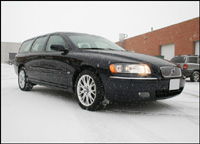 |
| The recently upgraded Volvo V70 made my snowy commute hardly eventful. (Photo: Justin Couture, Canadian Auto Press) |
blackened sky, the radio reports that over 100(!) accidents throughout the day have slowed traffic on every major route to a grinding halt. After sitting in nose to bumper traffic for what seems like an eternity, I finally pull into an unshoveled driveway, but at the moment I hardly want to leave the driver's seat even though a nice, warm bed calls my name. Yes, that's really how comfortable the
V70 is, a testament to an amazing set of front seats.
Six hours earlier, I was face to face with the new V70. New, you say? It's true - the new car actually features an slightly updated face and a few important improvements as a part of a mild facelift done last year. Volvo decided that the time was right in mid 2004 to give the V70, and its closely related siblings including the plastic-clad XC70 and the smaller S60 sedan, a mid-life update, but the visual changes are so minor and so subtle that you could call it sneaky.
Look closely and you might spot the new-look snout, which is softer, and rounder
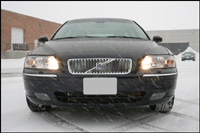 |
| Look closely and you might spot the new-look snout, which is softer, and rounder like the junior S40 and V50. (Photo: Justin Couture, Canadian Auto Press) |
like the junior S40 and V50. I find it interesting how Volvo started to revolutionize its styling, starting with the big, soft S80 and then working incrementally downward through its smaller models, like this V70, before finishing with its latest compact sedan and wagon, yet the facelift for these new 'large' cars, is styled after its newborn siblings. The updated V70 has taken a page from the smaller Volvos with its wider, bright chrome-plated grille and new clear headlamp clusters, which showcase bi-xenon self-leveling beams to light the way. Washer jets have replaced the miniature headlamp washers; one of the authentic Volvo trademarks now lost to increasingly stiff pedestrian safety ratings enforced by European crash test regulations. Angular foglamps and a new intake highlight the front bumper, while chrome-plated rub-strips, clear taillamps and a chrome-tipped exhaust pipe mark changes to the rear.
Under fluorescent lighting, the V70's handsome and classy full-size wagon profile remains thankfully unchanged, deeply
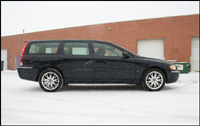 |
| The V70's handsome and classy full-size wagon profile remains thankfully unchanged. (Photo: Justin Couture, Canadian Auto Press) |
rooted in tradition rather than merely style for style's sake. The roofline and tailgate meet at ninety degrees; none of this funny low-roofed business you see in modern 'sports tourers' or 'lifestyle wagons'. Stylist Peter Horbury, now leading Ford's North American design direction, gracefully integrated the inherently boxy T-square shape into the car's 'Coke bottle' vertical profile and chiseled shoulders. This is quite unlike most other wagons on the market, which abandoned the theory of space maximization, including the V70's little brother, the V50.
Lift
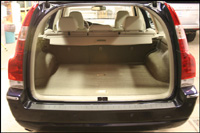 |
| Lift the tailgate and it becomes very clear that the people who design Volvos are of the most sensible sort. (Photo: Justin Couture, Canadian Auto Press) |
the tailgate, now branded with spread-out blocky, Volvo text logo, and it becomes very clear that the people who design Volvos are of the most sensible sort - or people who often shop at Ikea. The cargo bay at back is simply massive: without even folding down the rear seats there's 1,016 litres (35.9 cu-ft) of plush, carpet-lined space for you to put things in. It is so large, in fact, that two reasonably sized children can be seated in the trunk; so large that the use of the retractable cargo tethers is necessary when going grocery shopping to prevent bags from flying all over the place; so large that it could dominate over the living space offered by some Downtown condominiums that have recently popped up in the classifieds. It's probably more comfortable, too.
Oh, and that's not even with the rear seats folded down. Do that and the volume practically doubles to 2,022 L (71.4 cu-ft).
Not that you'd want to be lounging about in its trunk, especially since Volvo has gone to such great extremes to make the V70's
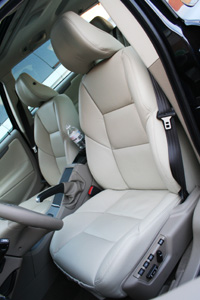 |
| This particular V7, equipped with Sport and Convenience Packages, includes sportier seats with more bolstering, trimmed in soft Swedish leather. (Photo: Justin Couture, Canadian Auto Press) |
cabin a place you'll really want to spend time in. This particular model, equipped with Sport and Convenience Packages, includes sportier seats with more bolstering, trimmed in soft Swedish leather. These back and bottom friendly seats are easily the best that I've ever planted myself in, offering just the right amount of lateral and leg support, and a full headrest that cradles your neck. Combined with a greater range of adjustability, I defy you not to be comfortable in them.
There's more to this update than just the seats though. To improve the car's 'living space', the centre console has been slimmed down for more room in the front footwells, while the console itself features a new stereo that actually includes buttons to save your favourite radio stations (not the previous dial selector). Thankfully the pictograph-style (and very effective) HVAC controls have been left alone. Elsewhere, there is a new console tunnel/centre armrest, which was redesigned to include a flip-over lid that uncovers a storage bin as well as two industrial-grade (family strength) cupholders for rear seat passengers. The interior quality has also been improved to match the sublime ergonomics, with finer-grained and softer touch plastics. The A-Pillars
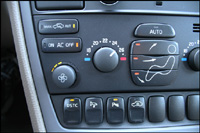 |
| Thankfully the pictograph-style (and very effective) HVAC controls were left alone during the upgrade. (Photo: Justin Couture, Canadian Auto Press) |
and sunvisors are now covered in cloth, while real walnut (instead of the prevous "environmentally friendly" woodgrain) and real aluminum accents are available. The real gray and real taupe plastic trim is also of better quality with leather-look grain.
Aside from plus-sized luxury limos like the Audi A8 or BMW 7-Series, there's really no other place I'd rather be than in this V70. Stuck in traffic? No problem, this car relaxes you so that you're refreshed by the time you get home. It's funny; every time I get behind the wheel I get this image of a happy family on a road trip to visit relatives. You know? The two kids in back, at least one of which is comfortably strapped into the integrated booster seat. In contrast to the warm and welcoming Volvo, German interiors from BMW and Benz just feel too cold, and too industrial for transporting your children.
With the same warm and honest approach, the V70 doesn't disguise the fact that it's big; which is unlike most of the new
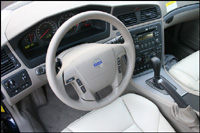 |
| At slow speeds the steering goes finger-tip light to make parking a doddle, while rear parking sensors take the guesswork out of reversing and three-point turns. (Photo: Justin Couture, Canadian Auto Press) |
European station wagons. You sit behind the thick-rimmed wheel, all nice and coddled by those wonderful seats; look in the rearview mirror and see the wagon's upright rear pillars far in the distance, standing strong and proud. It feels very wide and large on the road, looking and seeming much larger than its 5-Series-sized dimensions are, but just the same it's an easy vehicle to manage in more confined areas. At slow speeds the steering goes finger-tip light to make parking a doddle, while rear parking sensors (a highly advised option) take the guesswork out of reversing and three-point turns.
The whole 'big' factor works in favour of the V70 in one particular way - it gives a feeling of immense security. WHIPS, SIPS and many other protective systems do their job in practice, which contribute to peace of mind,
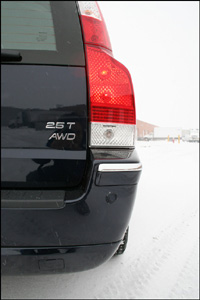 |
Volvo doesn't just crash test the V70 against a deformable or flat-faced barrier, they roll it, drop it upside down, smash it from every angle, even smash it at high speed against a solid Swedish mountain face! (Photo: Justin Couture, Canadian Auto Press)
|
and that added to the fact that this Volvo feels like it could shrug off an impact from a Mack truck. And as impossible as it sounds, I have no doubts that it could - Volvo's engineers are dead serious (hmmm... is that the right adverb to use? Ed.) when it comes to the
safety of those who buy their vehicles. They don't just crash test it against a deformable or flat-faced barrier as might be done by standardized government tests; they roll it, drop it upside down, smash it from every angle, even smash it at high speed against a solid Swedish mountain face!
As a part of the 2005 update, Volvo skipped over the engine department in the S60 and V70 - with the exception of the high-performance T5 model. The 2.5T model continues on, featuring variable valve timing and a light-pressure turbocharger to produce 208-horsepower, and 236 lb-ft of torque out of this small inline-five motor. By no means is this a quick machine, particularly since it's down by around 50-hp compared to most of its competitors, but the ratios in the standard five-speed Geartronic automatic are well suited to its broad torque band and low peak of just 1,500 rpm. The only problem with the V70 is that it's a heavy machine, and as such its thirst isn't exactly small. My 12.7 L/100 km (19 mpg) week-long average was a figure I'd expect to see out of an engine double its size.
But if you want all-wheel drive on your V70 without moving up to the high-performance 'R', you've got no other engine
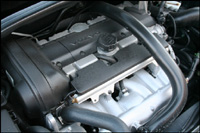 |
If you want all-wheel drive on your V70 without moving up to the high-performance 'R', you've got no other engine choice but the 208-horsepower light-pressure turbo-enhanced inline-five. (Photo: Justin Couture, Canadian Auto Press)
|
choice. The Haldex-based system is only available on the 2.5T model, which, unsurprisingly, is the sole powerplant for the jacked up and plastic-clad XC70. As for the system itself, it isn't the most advanced all-wheel drive setup on the market, but it adds a heightened sense of stability and grip when the weather turns fowl. With Pirelli P6 four-season tires at all four corners, the V70 still cuts through everything you'd find in a Canadian winter - snow, slush and even unplowed highway lanes without breaking a sweat, leaving drivers of large SUVs - ones supposedly capable of dealing with this kind of weather as well as off-road terrain - wondering what advantage they've
really got.
But just because it's turbocharged, and comes equipped with the Sport package that includes a large rear spoiler and some nice spangly alloy wheels, it should be noted that a name and a badge don't necessarily make it a sports car. The qualities that make the V70 2.5T such an excellent family and cargo hauler leave it too soft to be enjoyable when tossed about like a performance machine. While the grip from its wider tires and all-wheel drivetrain keep it firmly planted to the ground, its softly sprung suspension rolls excessively, and the steering is too light and too woolen
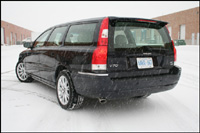 |
| The qualities that make the V70 2.5T such an excellent family and cargo hauler leave it too soft to be enjoyable when tossed about like a performance machine. (Photo: Justin Couture, Canadian Auto Press) |
to precisely plant it on a corner's apex. But, if shifting gears and shifting stuff are equal in your prerogative, the 300-hp V70R is probably your best bet.
I am disappointed that Volvo did not bring over two of their most impressive features available on global market V70s. One is the Four-C adaptive damping system, which first appeared on the high-performance S60/V70R, later adapted for the S80. With specially-tuned Ohlins dampers that have individual settings for sporty and comfort tuned driving, the system is said to proficiently adapt the car to the road surface below, constantly monitoring throttle and steering position. With this system on board, the V70's wonderful plush ride could be maintained while cutting back on pitch and dive during more aggressive driving, and further improve stability during high-speed emergency maneuvers.
Even more surprising is the fact that North American market V70s will miss out on the world's first blind spot monitoring system.
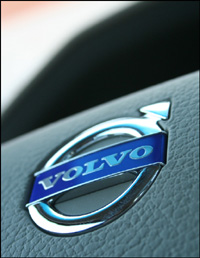 |
| The V70 2.5T AWD is an unpretentious, safe, large wagon, and excels at being just that. (Photo: Justin Couture, Canadian Auto Press) |
The BLindspot Information System (BLIS for short) is Volvo's latest breakthrough safety feature. It informs drivers of moving vehicles in their blind spot through the use of high-speed digital cameras mounted below the side-view mirrors. The system takes 25 photos per second, and compares each photo to determine if objects moving 20 km/h slower or 70 km/h faster are within the danger zone of 9.5 meters behind and 3.0 meters beside the vehicle. If a vehicle is detected in the BLIS zone, a warning lamp lights up on the A-Pillar indicating which side of the vehicle it is on.
Even without such advanced features, the revised Volvo V70 has left its mark in a way that few other cars have; the improvements building on a car that was already very good. The V70 2.5T AWD is an unpretentious, safe, large wagon, and excels at being just that; mostly because it doesn't try to be something it's not, like a crossover or an oversized sports car. It is, I fear, the last of a dying breed. As an owner of the car's predecessor, the first-generation V70 AWD Turbo, the new model fortifies Volvo's strengths of safety, practicality and above all extremely comfortable seats. As such, if I ever get to the point where I settle down with wife and kids, I know where to go for the perfect family vehicle.
Specifications:- Price Range (V70 2.5T AWD MSRP): $47,120 - $62,170
- Price as Tested (MSRP): $58,570
- Body Type: 5-door wagon
- Layout: front engine, AWD
- Engine: 208 hp, 236 lb-ft of torque, 2.5L, 20-valve DOHC I-5
- Transmission: 5-spd automatic
- Brakes (front/rear): disc/disc, ABS, EBD
- Dimensions (L/W/H/WB): 4,710 / 1,804 / 1,465 / 2,755 mm (185.4 / 71.0 / 57.6 / 108.5 in)
- Curb Weight: 1602 kg (3531 lbs)
- Tires: 235/45R17
- Capacity (seats up/down): 1016 / 2022 L (35.9 / 71.4 cu ft)
- Fuel Economy (city/hwy): 11.9 / 7.9 L/100 km (20 / 30 mpg)
- Observed Fuel Economy: 12.7 L/100 km (19 mpg)
- Warranty (mo/km): 48/80,000 km comprehensive
- Competitors: Audi A6 Avant, BMW 5-Series Touring, Chrysler Pacifica, Dodge Magnum RT, Ford Freestyle, Lexus RX330, Mercedes-Benz E-Class Wagon, Saab 9-5 Wagon, Volkswagen Passat Wagon
- Website: www.volvocanada.ca











